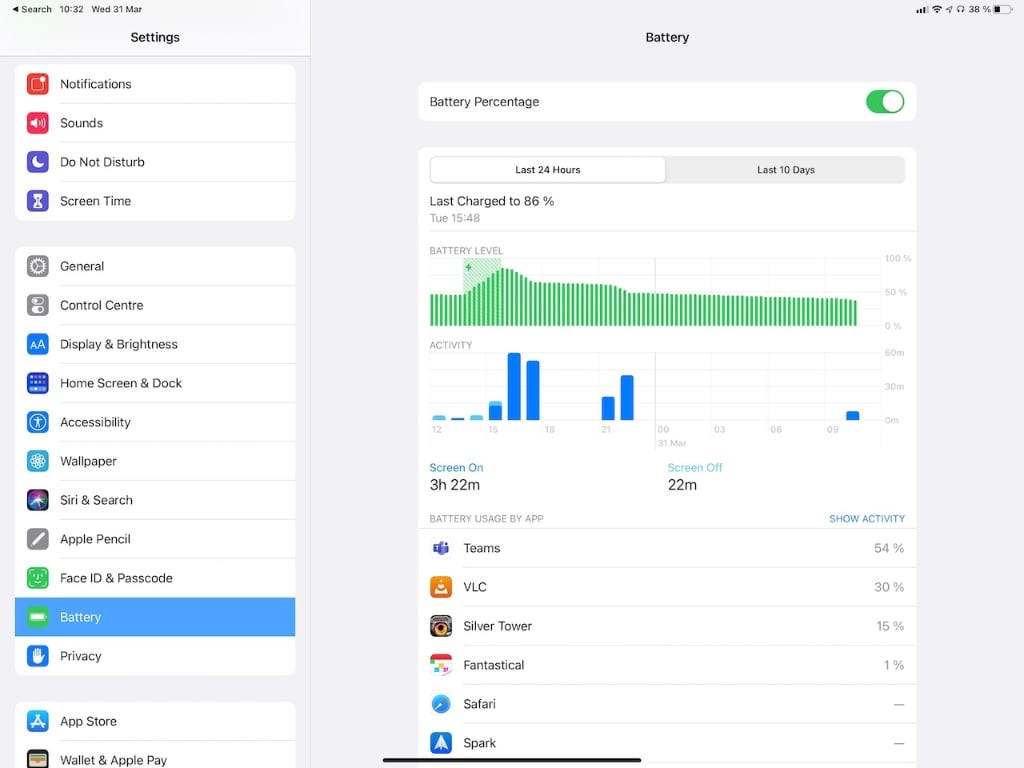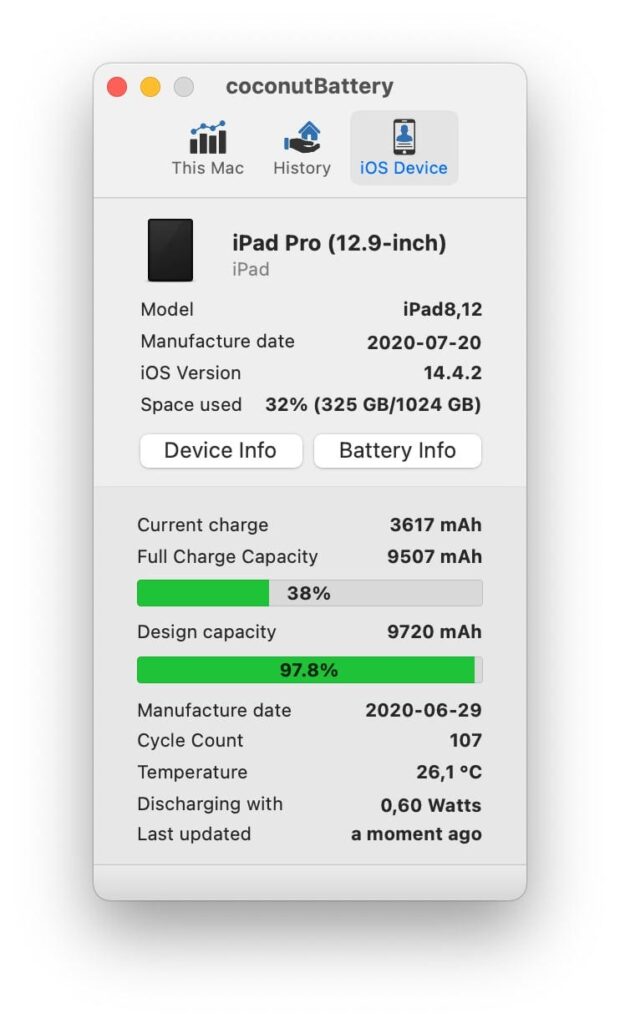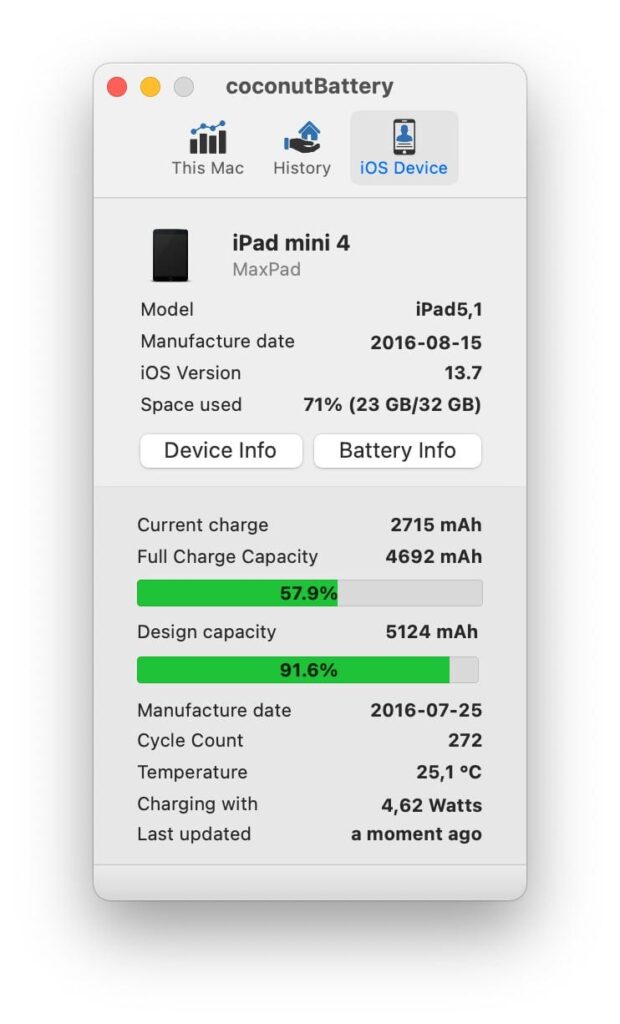🆓 This member post is free for all, thanks to our paying subscribers. Enjoy!
Hello!
If you’ve ever sold an Apple device, you’ve probably noticed that some buyers are extremely interested in not only battery life, but battery health. Questions like ”how many cycles?” are common.
So, how is your battery doing? Let’s talk batteries!
Sound battery usage
There are many ideas as to how a device should be treated to get the most out of its battery. A lot of these aren’t relevant anymore, advice made obsolete because we’re now using lithium-ion batteries. They’re still finite products, lithium-ion batteries degrade and that’s why the cycle amount is relevant because the batteries can be charged an average number of times before performance gets noticeable. For iPads, that used to be 1,000 cycles and thereafter you could expect about 80% performance from the battery. That’s not necessarily true for all iPad batteries, but it gives you an idea of how long an iPad battery might live.
So, how should you treat your battery?
- Charge you iPad when you need to. It doesn’t matter if it’s at 60% or at 15%.
- Charge your iPad to the level you need and have time for. It doesn’t have to be to a 100%, it could just as well be to 75%, or whatever.
- Avoid letting your iPad hit 0%. If it does, charge it right away. The battery isn’t really empty (it’s not really full att 100% either), but if it were to drain completely, it’s dead.
- Charge using quality cables and chargers. The actual charging unit is located in the iPad, and it’ll pull as much power from the outlet as it is capable of. This also means that you don’t need to worry about using a MacBook charger for your iPad Pro — it’ll just use what it can anyway.
- When plugged in and charged to a 100%, only minimal strain is put on the battery. The iPad is essentially running on wired power. That means that charging overnight isn’t a bad idea at all, with the added benefit of being able to run iCloud backups and other background activities uninterrupted by the user. Some will say to keep your device from hitting 100%, but Apple claims their handling this, so you should be fine.
As you’ll see, there’s no ”drain your device every now and then” or ”always charge to 100%” advices here because there’s no benefit of the latter, and the former is even theoretically fatal for the battery. Those things were relevant for other forms av batteries, but lithium-ion is a different beast.
📦 Long-term storageIf you’re going to store your iPad for a longer period of time, Apple recommends charging it to about 50%, power off, and top it up every six months.
Getting the most out of your battery
I’m sure you’ve noticed that, at times, your battery empties faster. This usually isn’t hardware related, it’s the software. There might be issues in iPadOS, something beta users have noticed over the years (battery life in betas is usually worse to begin with), or it can be an app that drains a lot of power. This includes background processes, so if you feel you’re not getting as much usage per charge as you expect, it’s probably a good idea to check which apps you allow to operate in the background.

This brings us to the Battery section of the Settings app. This gives you an overview of your usage over the last 24 hours, and the last ten days. It shows which apps are using up your juice, and by comparing that to your actual usage (Screen Time is a good feature for this), you can single out the culprits.
Apps running processes in the background is another common culprit to rapidly draining batteries. You can find those in Settings as well, under General and then tapping Background App Refresh. Some apps are obviously fine to have running in the background, but do you really need all of them? Toggle as needed.
Finally, having a poor connection to a cellular network, or a Wi-Fi network, can drain the battery as well. If you don’t need that particular connection, turn off Wi-Fi or just enter flight mode. To be fair, this isn’t often a solution but rather a panic fix when you’re too far from a charger. Who gets by without the internet these days, after all?
How’s your battery health?
If you have an iPhone, you might’ve noticed the battery health section of the Battery section in Settings. It’s unfortunately not available on iPadOS, for whatever reason, so checking your battery health requires external sources. There are apps that can monitor runtimes and the like, but if you want real in-depth knowledge as to your battery’s health, you need to connect your device to a computer (I use a Mac) and run a diagnostics app. If you’re a Mac use, I can recommend CoconutBattery, a free app with a pro version that gives you a sense of how your battery is doing.
Here’s my 2020 iPad Pro:

Compare that to an old 2016 iPad mini that the kid’s using:

Fifty-five months in, the iPad mini’s battery health is at 92% and 272 cycles. The iPad Pro, meanwhile, has seen eight months of use and has a battery health at 98%. Makes sense. Looking at the images above, you’ll see the battery’s charge capacity for each device, as well as how much is actually available. Granted, some of what’s not available might be the don’t die when hitting 0% buffer I mentioned above. I’m sure a battery expert could shine further light on the matter.
As a side-note, I find it interesting that the iPad mini 4 from 2016 is in such good shape. It has had inactive periods, hit 0% more times than I can count, been forgotten in a drawer, crossed continents, and is pretty beaten up. It’s a prime example of a device that hasn’t gotten as much care as it should have, with no thoughts to battery health, and yet here we are. The lesson is to not worry so much about these things.
I hope this issue shed some light on the mysterious topic of batteries. Personally, I don’t worry about these things, but if you want your device to last a long time, it’s obviously a good idea to follow best practices. The most important thing would be regarding long-term storage, since a fully drained lithium-ion battery — as in really drained, not just 0% — is effectively dead and must be replaced.
Do you have thoughts? Hit me up on Twitter and share. You can also comment on this post, or hit reply if you’re reading this in your email client.
Until next week, stay energized. 🔋
